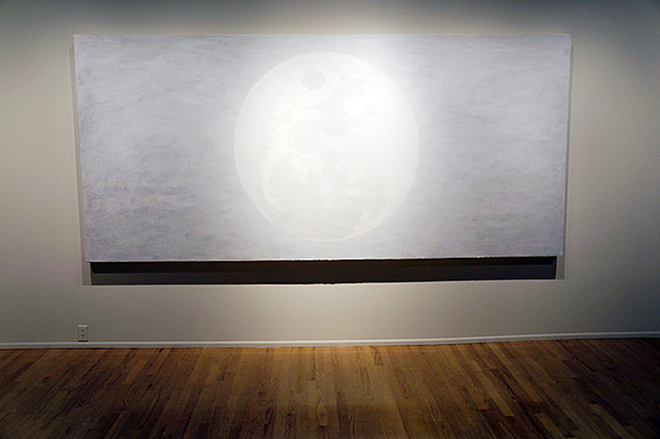In the Blue Crest by Carol Mickett and Robert Stackhouse

MICKETT/STACKHOUSE
MOON SHINE: One of the two Selby canvases is a 12-foot-long, 5-foot-tall white-on-white painting of the moon. The finished orb hangs on the canvas uncannily like the actual moon.
A growing number of St. Petersburgians know Carol Mickett as the insightful interviewer behind — and on stage during — "Our Town," a monthly conversation she stages at the Dalí Museum with a St. Pete newsmaker. (Recent guests have included [email protected] co-founder Bob Devin Jones and Jyotika Virmani, an oceanographer whose popular blog fuses science and humor while tracking tropical storms.) But Mickett is better known to many in the art world as half of Mickett/Stackhouse, the collaborative duo she makes up along with her husband, Robert Stackhouse, a longtime visual artist whose career highlights include receiving multiple NEA grants and having chaired the Corcoran School of Art's BFA program, not to mention seeing his art collected by the Museum of Modern Art, the National Gallery of Australia, and other museums. Since the couple began collaborating in 1999, their projects have included building a 140-ton public sculpture in Indianapolis out of limestone with the help of volunteers (who were taught to carve stone by the artists) and, in 2008, crafting a 2,400-square-foot sculpture out of cypress wood inside St. Pete's Morean Arts Center that visitors could walk through.
While once unimagined and perhaps unimaginable, today the Mickett/Stackhouse collaboration represents such a decisive integration of minds and talents that the couple refers to Stackhouse's prior solo work as "B.C." or "before Carol."
This month, their latest output is the focus of two Sarasota exhibitions. The first, Phases of Identity: Carol Mickett and Robert Stackhouse at Ringling College of Art and Design's Selby Gallery, features a room-filling installation — constructed mostly out of cypress, one of their preferred materials — and a pair of large-scale paintings. Just before that exhibition closes on Feb. 16, Allyn Gallup Contemporary opens Tidal Works, a showcase of the couple's paintings and prints, on Feb. 14.
The subject of the new Mickett/Stackhouse work is one that resonates with their own collaborative mergence: Identity. During an interview at their waterfront studio in Old Southeast, both artists described their focus as an organic outcome of a process that combines their individual skills. Initial inspiration often comes from conversations about philosophical ideas introduced by Mickett, a philosophy Ph.D and former college professor — in this case, questions posed by pre-Socratic philosophers of ancient Greece about the essential nature of being. For some of those philosophers, identity presented a conundrum in a world where everything is constantly changing and yet people, places and things seem to possess an underlying constancy.
"That's how the whole notion of a soul comes to be," Mickett says. "You have to postulate something [about a person] that's not changeable."
In prior work, the couple homed in on a cosmological pronouncement by Thales, a pre-Socratic philosopher who believed that all substance was ultimately composed of water. (Not a crazy idea when you consider that the average human body is about 60 percent water.) Their paintings glimmered deep blue and explored the ambiguity of place in an ever-flowing world; the Morean installation, bathed in blue light, conjured a spare and vaguely sacred underwater architecture. Now they have a new mascot for the flux and inscrutability of existence: the moon. Though Earth's constant companion, the white orb remains essentially strange — we'll never see its dark side with the naked eye. Though a habitual sight, the moon is perpetually changing. And what we see of the moon isn't so much the moon itself as its reflection of another: the sun.
"The moon becomes a metaphor for who we are in the world," Mickett says.
All this is the stuff of abstract conversations that, frankly, aren't really needed in the face of the work. One of the two Selby canvases is a 12-foot-long, 5-foot-tall white-on-white painting of the moon that doesn't require any instructions. Visitors will simply be magnetically lured to sit in front of it for improbable lengths of time. (I sat for more than 20 minutes and left only because the gallery was closing.) Its luminosity is insane — no more formal term will do — the product of an "emotionally traumatic" process of painting and repainting the orb in layers of translucent white acrylic paint until the perfect degree of detail versus invocation was achieved, Stackhouse says. The finished orb hangs on the canvas uncannily like the actual moon, with perceptible mass and volume.
The installation, titled "Breath of Cypress Moon," offers an experience of phase-based existence engineered for the human body. The 8-foot tall cypress wood sculpture is shaped like a wheel with eight spokes. On one half of the wheel, a row of white paper strips hangs from each of the white-washed spokes overhead, creating scrims between pie wedges of the moon's lighted face; on the other, dark side, golden cypress slats create a lattice-like roof over the structure, plunging its interior into shadow. A walk through and around the sculpture gives a visitor the sense of waxing and waning, of choosing to explore or dwell in the light or dark side of oneself. (The third piece in the exhibition is a ghostly, white-on-white painting of the structure.)
Perhaps this is the ultimate commentary on identity to take away from Mickett/Stackhouse's latest project: You thought you knew the moon until this exhibition. Despite its familiarity through everyday experience, countless poems and songs, "there's a way of looking at the moon that if you explore it, all of a sudden you see something different," Stackhouse says. "We're using our combined abilities to reflect that."
Source: https://www.cltampa.com/arts/mickettstackhouse-satellites-of-love-12283367